© 2014-


Radio Antwerpen - History
Georges de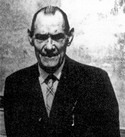 Caluwe, inspired by the success of offshore radio in Scandinavia and neighbouring Holland, decided to re-
Caluwe, inspired by the success of offshore radio in Scandinavia and neighbouring Holland, decided to re-
Georges de Caluwe was an Antwerp radio engineer who in 1922 had been granted a licence to establish the first local commercial radio station in Belgium. That station was Radio Antwerpen (with the call-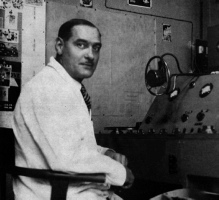 hurch) because its transmitter was located on a church tower.
hurch) because its transmitter was located on a church tower.
Early in 1940, with the Nazi war machine threatening his country de Caluwe's station was forced by the Belgian Government to relay the programmes of NIR, the then state radio service. In May of that year, as Nazi forces were about to overrun Belgium, de Caluwe decided that he must destroy the transmitter to prevent it being used for propaganda broadcasts by the invading army.
During the years Belgium was occupied he secretly built another transmitter so that in 1945 with the end of hostilities Radio Antwerpen would be able to return to the air. However, the Belgian Government on its return from wartime exile in London decided that all radio stations would in future be state controlled and , despite putting up a fight to regain his former licence, de Caluwe was forced to close Radio Antwerpen on 31st August 1948 when all his broadcasting equipment was confiscated.
He appealed many times to have his licence reissued, but without success so, in 1962, frustrated by the years of bureaucratic delays and refusals to grant him a licence he decided to resurrect Radio Antwerpen, this time from a ship off the Belgian coast.
He purchased a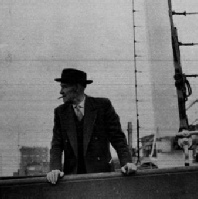 concrete built ex-
concrete built ex-
The Uilenspiegel was finally equipped by October 1962 and she left Antwerp Harbour to anchor outside Belgian territorial waters off Zeebrugge. Test transmissions started on 12th October 1962 with regular programmes commencing on 15th October 1962.
In November 1962 Radio Antwerpen also began transmitting its programmes on short wave and reception reports for these broadcasts were received from as far away as Canada. Later that same month the station encountered its first storm at sea and was forced to leave the air after putting out a distress call. The aerial had collapsed during the storm, but engineers managed to carry out emergency repairs and transmissions resumed the following day.
The Belgian Marine Offences Act was passed on 13th December 1962 and became effective five days later. By a tragic coincidence on the same day that the legislation was passed Georges de Caluwe died in an Antwerp hospital following an operation.
During the night of 15th/16th December 1962 the Uilenspiegel was battered by strong winds and heavy seas. The crew discovered that part of the ship had become flooded and the shortwave aerial had fallen on the medium wave mast causing damage to both transmission facilities. The Uilenspiegel herself began to drift just before noon on 16th December 1962 and by 3.30pm had drifted to within a mile of Zeebrugge, six of the ten crew were taken off by the lifeboat.
Four crew members remained on board the Uilenspiegel as a tug started to tow her towards Flushing, but by 4.30pm, when the vessel was a mile off Knokke, the weather had deteriorated so much that the lifeboat made an attempt to take aboard the remaining crew . However, because of engine trouble the lifeboat itself was forced to return to port and shortly afterwards the salvage tug's tow rope snapped. Despite this setback the tug managed to rescue the crew from the Uilenspiegel shortly before the radio ship ran aground at Cadzand, just 500 yards inside the Dutch border.
No attempt was mad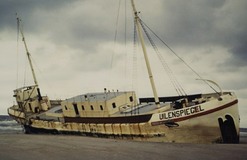 e to salvage her and eventually, stripped of all equipment by vandals, she gradually sank into the sand. The wreck of the Uilenspiegel remained on Cadzand beach for nine years before being blown up in 1971 by the authorities who considered it had become a safety hazard.
e to salvage her and eventually, stripped of all equipment by vandals, she gradually sank into the sand. The wreck of the Uilenspiegel remained on Cadzand beach for nine years before being blown up in 1971 by the authorities who considered it had become a safety hazard.

Georges de Caluwe
The stranded wreck of Uilenspiegel on Cadzand beach

Click on picture to enlarge
Video showing the Uilenspiegel stranded on Cadzand beach, December 1962.
(Note the caption date is incorrect it should read 16th December 1962)
Video showing the various aspects of Radio Antwerpen and the Uilenspiegel .

History
Key Dates
Ship and Location
Technical
Staff




Programmes

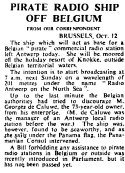
The Times
13th October 1962
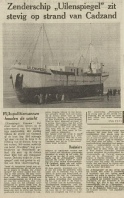
Unknown Publication
17th December 1962
Georges de Caluwe at Radio Kerkse
Photo: Hans Knot
Georges de Caluwe on board the Uilenspiegel
Photo: Hans Knot
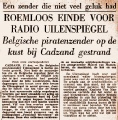
Unknown Publication
December 1962

Back to Radio Antwerpen


Back to Netherlands/Belgium Gallery
